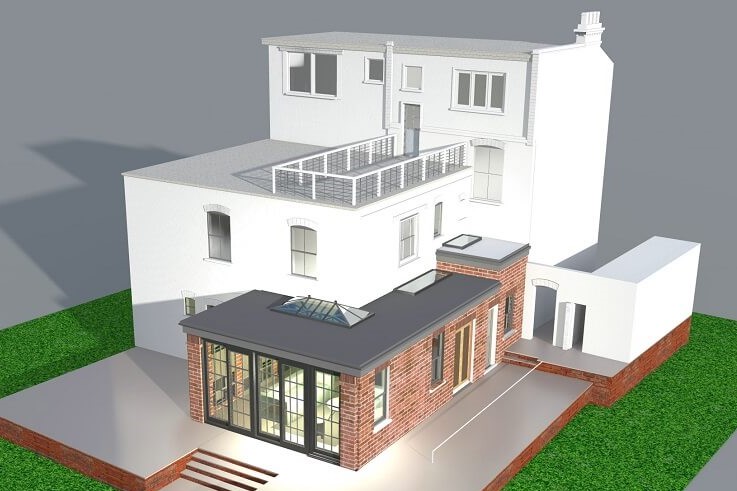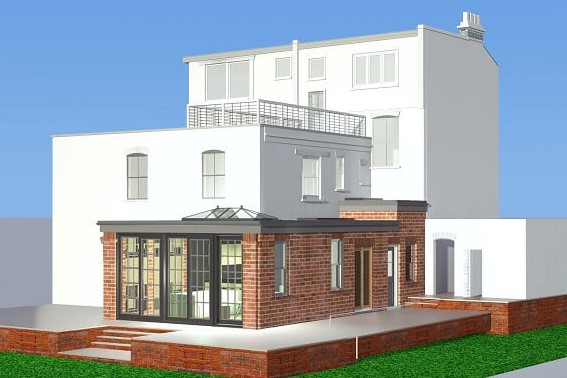Guide for single storey extensions
Single storey extensions are one of the most common home improvement solutions for most homeowners in the UK. Having a single storey extension is also a cost-effective option. It’s one of the options you can choose to spruce up your home, acquire some extra space or even improve your property’s value.

Another thing that makes single storey extensions such a common option is the fact that there’s a wide array of options that you can consider when it comes to style and design. Whether it’s a kitchen extension, an extra bedroom, a home office, or perhaps an orangery, there are plenty of other modifications that can be achieved.
However, your needs will dictate the most suitable option because you can’t have an office extension when you need an extra bedroom. In this comprehensive guide, we shall look at some of the important things you need to know before embarking on a single storey extension project.
Types of single storey extensions
There are several types of single storey extensions that you can opt for depending on the type of property you have. These options are no different from the two storey extension options that you can opt for. Some of the single storey extension ideas include the following:
Rear extension
This is one of the common types of house extensions in North London and the UK. with rear extensions, you extend towards the back of your home. It’s even better if you have adequate garden space on your property. A rear extension can radically change your property for the best depending on what you choose to do with it.
You can have either a kitchen extension, an orangery, or perhaps a lounge space. In most cases rear extensions are more suited for either detached or semi-detached properties where they guarantee you a larger and wider space.When it comes to terraced homes, the extension will be narrower and deeper. The style of your single storey extension will depend on the design of your original house.
Side return extension
Side return extensions are a common option for most Victorian and Edwardian properties in the UK. With a side return single storey extension, you get to make the most of the usable space at the side of your property.
Depending on the number of feet you extend with, you can dramatically increase the width of your property which will undoubtedly have an impact on the extra space you’ll gain. It’s important to note that a Party wall agreement may be necessary especially if you have a shared wall with your neighbours which may need to be altered.
Wrap around extension
A combination of the side return extension and the rear extension, the wrap around guarantees you a significant increase in the size of your home. They’re also an ideal choice for either period homes or modern properties. Detached and semi-detached properties are also suited for this type of extension.

Why should I have a single storey extension
There are different types of extensions that you can opt for depending on the type of property you have and the design that you intend to achieve. There are many benefits that you can get to enjoy from having a single storey extension. These benefits include the following:
- It’s a cost-effective alternative to moving out or building a new home. Extending your home is more affordable compared to starting to plan a whole new construction project.
- You get to acquire additional space. A single storey extension is one way to get more extra space in your property. Whether you want to acquire an extra bedroom to accommodate your growing family or visiting guests, you get to achieve this with a single storey extension.
- A single storey extension also provides a great opportunity to improve the overall appearance of your home. You also get to incorporate your dream design in your new space.
How much will a single storey extension cost
There are several factors that influence the cost of a single storey extension hence there’s no standard cost. However, on average, a single storey extension can cost you anywhere from £15,000 upward. Some of the things that will influence this include the following:
- Your budget
- The location of your property
- The complexity of the design you choose
- The size of your extension
- Building control fees
- Planning control fees
- The type of builder you choose to work with

Do I need planning permission
Before commencing any construction project, be it a renovation, extension or new build, it’s advisable to check with the local planning authority whether you’ll need any planning permission. For single storey extensions, most of them can be done without any planning permission because they fall under permitted development rights.
Here are some of the things your single storey extension needs to adhere to for it to fall under permitted development rights.
- The single storey extension shouldn’t extend up to a certain limit beyond the rear wall of the original house. For detached houses the limit is four meters whereas for any other types of houses the limit is three meters.
- If your home isn’t in a conservation area or designated land, then you can extend your single storey up to 8 meters for a detached property and 6 meters for any other type of house.
- The single storey extension cannot exceed four meters in height.
You also need to consider the type of building materials used for the exterior of your home. The building materials should be the same as those of the existing house. It’s also important to note that only half of the original house can be extended.
If your single storey extension is bound to exceed any of the above requirements, then you’ll need to apply for planning approval from the local authorities. You also need to put your neighbours into consideration before commencing your project.
The local authority will notify them of the planned project and if there’s any objection from them, you’ll be notified whether you’ll need to have any planning approval.
Also if you happen to share a wall with your neighbour, you might need to consider the party wall act. This is especially if your single storey extension project is likely to cause any disruption to your neighbours.

What other legal requirements should I consider
Apart from acquiring planning permission if your project doesn’t fall under permitted development rules, there are other requirements that you should consider before embarking on your single storey extension. These include:
The Party Wall Act
The Party Wall Act is particularly common if you’re planning on having a single storey extension on either terraced or semi-detached home. If you share a wall with your neighbours, the local authority will have to give them a Party Wall notice before the project commences. You should also consider your neighbours right of light before embarking on your construction project.
Building regulations
Every construction project is required to adhere to the building regulations requirements. The building regulations ensure that the single storey extension adheres to the health and safety requirements as well as the minimum standard for carrying out the extension.
Your architectural team should work closely with the structural engineer to submit the plan drawings for building control approval. It's advisable to acquire a lawful development certificate which proves that your single storey extension did not need any planning permission.
Do I need an architect for a single storey extension
Although not necessary, an architect is a very crucial aspect when it comes to submitting the plans for planning application/approval. You will need professional architectural drawings during the planning process for you to acquire any planning permission.
These drawings could also come in handy when applying to building control because they need to be clearly detailed to make the process easier. You can always consult with your builder to establish whether you will need an architect for extension.
Roofing options for single-storey extensions
When it comes to roofing for single storey extensions, there are several options that you can consider. There are less limitations on the type of roofing you choose unlike if it were a two storey extension. Some of the roofing options you can consider include the following:
- A flat roof: Flat roof extensions are the most common option for most homeowners especially for those considering a more affordable option. You can spruce up the flat roof design by using metal cladding or incorporating glazing. For more natural light, you can also have skylights or roof lanterns on your flat roof. Glass roofs are another popular option for side return extensions which allow a lot of natural lighting to flow into the living space.
- A sloping roof: With this option, you can always opt for a roof that slopes towards the existing house. For a seamless look, you can opt for roof tiles that look similar to those of the original house.
- A gabled roof: Aside from being aesthetically pleasing on the outside, a gabled roof also makes your extension look and feel more spacious. For a striking look and to allow light into the living space, you can consider glazing the gable end roof.

Exterior finish ideas for single storey extensions
There are plenty of options to consider for exterior finish ideas for your single storey extension.
- Cladding: This is one of the common options when it comes to exterior finish options. The different cladding materials can range from timber, to fiber cement painted cladding among other options.
- Matching the extensions brickwork with that of the original building. This comes in handy if you also want to ensure that your single storey extension falls within the permitted development rights.
- Rendering is yet another option you can consider especially if you’re looking to achieve a seamless look for your home. It also makes your extension stand out.
How long does a single storey extension take
A single storey extension can take anywhere from three months onwards. This is of course if you have already taken care of other requirements like acquiring planning permission and choosing a reliable builder for your project.
When it comes to the builder, you should ensure that they don’t have other projects going on because if they decide to prioritize them more than yours then it will most likely take a longer period to complete. Also looking at their previous projects and reviews from previous clients is an ideal way to find out if they are legit or suited for the job.
Other things like bad weather and shortage of building materials can lead to an extended period for the completion of the project. The size and complexity of your project will also have a significant impact on your project’s duration. It’s good to give an allowance for any unplanned events that may interfere with the completion date of the single storey extension project.
From this simple guide, it's evident that there’s a lot that goes into having a single storey extension. You can also see that having a qualified and reliable builder goes a long way in achieving a seamless single storey extension project. It also gives you an estimate of the duration your project is likely to take.
You also get a glimpse of the legal requirements you need to adhere to for your project. You certainly want to avoid any complications that may arise while your project is underway. Proper planning is always crucial before embarking on any construction project of any kind. All in all, a suitable builder will help you achieve your dream design without compromise.
